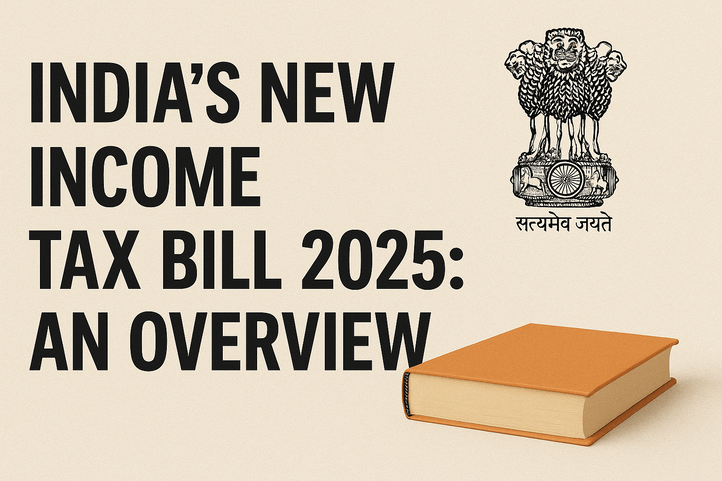In February 2025, India introduced a landmark piece of legislation—the Income‑tax Bill, 2025—aimed at overhauling the country’s direct tax framework. Presented in the Lok Sabha on February 13, 2025, during the Union Budget, the Bill seeks to replace the Income‑tax Act, 1961, which has undergone over 65 amendments and 4,000 changes since its enactment.
The Bill’s primary objective is to simplify the law, increase transparency, and ensure digital readiness, while leaving core tax rates and exemptions unchanged. Once passed, it is expected to come into effect from April 1, 2026.
This article explores the condensed structure, new provisions, privacy debates, select committee recommendations, and why a Tax Book or reference guide will be essential for navigating this transition.
1. A Streamlined Framework
The Income‑tax Bill, 2025 significantly reduces the size and complexity of the existing statute:
- Shrinks from 823 pages to 622 pages,
- Reduces 52 chapters down to 23, and
- Consolidates 16 schedules.
A key reform is the introduction of a single “Tax Year”, replacing the earlier “previous year” and “assessment year” system. This uniformity will improve compliance, especially for startups and new businesses.
Crucially, there are no changes to tax slabs, exemptions (Sections 80C, 80D, etc.), or surcharge levels. The regimes introduced in Budget 2025 for FY 2025‑26 remain intact.
2. Tax Slabs and Standard Deduction
The Bill continues with the new tax regime as the default option:
- Individuals with income up to ₹12 lakh pay zero tax.
- A standard deduction of ₹75,000 effectively raises the tax‑free limit to ₹12.75 lakh.
These provisions maintain continuity and reflect the announcements made in Budget 2025.
3. Digital Search Powers and Privacy Concerns
One of the most debated provisions is Clause 247, which expands tax officers’ powers to the digital realm.
The term “virtual digital space” includes:
- Social media and email accounts,
- Cloud storage and encrypted data,
- Banking and trading platforms.
Under Clause 247(1)(b), officers can request or bypass access controls to obtain data if taxpayers do not comply voluntarily.
The privacy debate
- Critics argue that these powers jeopardise digital privacy, undermine encryption, and could lead to taxpayer harassment. Organisations like the Global Encryption Coalition have raised red flags.
- Supporters, including CBDT Chairman Ravi Agrawal, maintain that the provision clarifies existing authority under the 1961 Act and includes internal controls for data integrity.
Parliamentary select committee chair Baijayant Panda later clarified that the goal was to remove ambiguities rather than introduce new search powers.
4. Recommendations by the Parliamentary Select Committee
The Select Committee’s July 16, 2025 report contained 285 recommendations to improve the Bill. Highlights include:
- House property income:
- A 30% standard deduction on gross rental income after municipal taxes.
- Restoring home loan interest deductions for let‑out property.
- Procedural powers:
- Granting income‑tax officers select powers under the Civil Procedure Code, including the ability to issue summons.
- Digital safeguards: Clearer checks and balances when accessing digital accounts.
- Small business support: Streamlined TDS procedures, simplified faceless assessment timelines, and provisions for family‑owned businesses.
5. Impact on NRIs and Digital‑First Taxpayers
The Bill refines the residential status rules for NRIs, simplifies cross‑border compliance, and addresses deemed income concerns.
For digital‑age earners such as social media influencers, F&O traders, and commission agents, the Bill introduces new ITR codes:
- 16021 for influencers,
- 21010 for F&O traders, among others.
While this will enable better classification, there is concern about misclassification, regime selection, and audit triggers. A dedicated Tax Book can help professionals interpret these changes accurately.
6. Capital Gains and Filing Deadlines
Although the Bill does not directly change capital gains taxation, earlier reforms from July 2024—such as revised short‑ and long‑term capital gains rates—still shape the current compliance calendar.
The ITR filing deadline for AY 2025‑26 has been extended to September 15, 2025 (from July 31), reflecting these structural changes.
7. The Importance of a Tax Book
Given the scale of legal and procedural changes, a well‑curated Tax Book or reference guide will be invaluable for both taxpayers and practitioners. An ideal Tax Book would include:
- A section‑by‑section comparison of the old Act and the new Bill,
- Flowcharts explaining the unified Tax Year concept,
- Detailed insights on Clause 247 digital powers and taxpayer rights,
- Capital gains computation rules,
- Examples and case studies for digital and gig‑economy taxpayers.
This type of resource will simplify navigation during the transition and ensure accurate compliance.
8. Key Highlights at a Glance
| Theme | Summary |
| Timeline | Introduced Feb 13 2025; committee report July 2025; expected effect Apr 1 2026. |
| Structure | 23 chapters, 16 schedules, 536 clauses—about half the size of the 1961 Act. |
| Tax Rates | No change in slabs or rates; ₹12 lakh exemption and ₹75,000 standard deduction preserved. |
| Digital Powers | Clause 247 enables search in virtual digital space; privacy concerns remain. |
| Committee Input | 285 recommendations, including enhanced deductions for house property. |
| Digital Economy | New profession codes for influencers and traders to improve reporting clarity. |
Conclusion
The Income‑tax Bill, 2025 reshapes India’s direct tax law by consolidating the existing statute, adopting a unified Tax Year, and recognising the realities of a digital economy.
While the Bill does not change tax rates, its digital search powers continue to spark debates on privacy and taxpayer rights. The final shape of the law will depend on how the government implements the 285 committee recommendations, particularly those around data safeguards and procedural fairness.
As the Bill moves toward its April 1, 2026 rollout, taxpayers and professionals should invest in a detailed Tax Book to bridge the gap between the 1961 Act and the new provisions. Such a guide will provide clarity, reduce compliance risk, and ensure a smoother transition into India’s updated tax framework.
